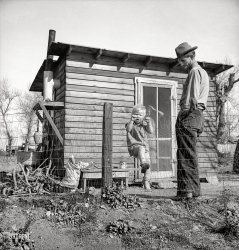
MAY CONTAIN NUTS

Search Shorpy
SHORPY ART

Framed or unframed, desk size to sofa size, printed by us in Arizona and Alabama since 2007. Explore now.
Join and Share
Ad-Free Shorpy
Shorpy is funded by you. Patreon contributors get an ad-free experience.
Learn more.

Recent comments
- Recent view
- Hudson’s Big Store
- Say what??
- Grapes?!
- A Beautiful Moment
- Such joy
- Bethune-Cookman University today...
- Yellow sky at morning
- Side Winder
- Air Quality?
- Sojourner Truth riot
- None were so blind(ed)
- The less famous sister
- Good ol' days?
- Rise and Fall
- Goo Goo Ga Joob
- Ticket Retention
- Not the only one
- Vagaries of War
- Killed by Amtrak
- Back to the Future
- Wanted --
- If you can't stand the light
- Centralized Traffic Control, I believe
- What's really happening
- Heckuva remote control!
- Sometimes — Things Go Bump!
- I SEE THE LIGHT
- Union Switch and Signal Company
- Get That Light Out Of My Eyes
Member Photos
The Shorpy
Print Emporium
Print Emporium
Search Shorpy
Search results -- 30 results per page
- Got a Light?
- ... View full size. Medium-format nitrate negative by Dorothea Lange for the Farm Security Administration.
Curing Time I really love ... Posted by Dave - 01/20/2008 - 2:01am -
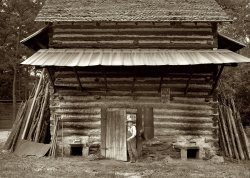
- Following the Harvest: 1939
- ... wants to return to Oklahoma, father unwilling." Photo by Dorothea Lange for the Farm Security Administration. View full size.
Mangum, OK ... Posted by Dave - 06/18/2017 - 2:06pm -
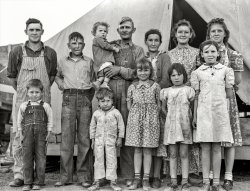
- Golden (State) Boys: 1938
- ... on the flats outside of Bakersfield, California." Photo by Dorothea Lange for the Resettlement Administration. View full size.
Masterful ... Posted by Dave - 02/11/2017 - 1:29am -
![Golden (State) Boys: 1938 November 1938. "Children of [Dust Bowl] refugee families now on Works Progress Administration. They live in tents on the flats outside of Bakersfield, California." Photo by Dorothea Lange for the Resettlement Administration. View full size.
MasterfulThe well-respected camera woman achieves a technical masterwork with this extreme backlit shot. Or has Shorpy come to the rescue and opened up the shadows and let us see the Depression-be-damned happiness of the three boys?
Great picI love the effect of the backlighting in this photo. I've never heard the term "refugee" used with folks affected by the Dust Bowl. It makes me wonder if the term is used out of ignorance or as a political statement. Neither scenario would be flattering to the author.
[Any ignorance here might be ours. A refugee is a person seeking refuge. The term was widely used during the Depression when referring to the victims of Dust Bowl-era drought and flooding. - Dave]
Flashbulb?Back then it was not difficult to overpower the sun with a flashbulb, so probably likely there was some fill flash on this shot. That, or it is a masterful print or scan of the original neg.
[Any "fill flash" effect is courtesy of Photoshop. - Dave]
(The Gallery, Dorothea Lange, Dust Bowl, Kids)](https://www.shorpy.com/files/images/SHORPY-8b32595a.thumbnail.jpg)
- A Place to Call Home: 1939
- ... State. August 1939. View full size. Photograph by Dorothea Lange.
(The Gallery, Dorothea Lange, Great Depression, Kids) ... Posted by Dave - 07/05/2009 - 2:43am -
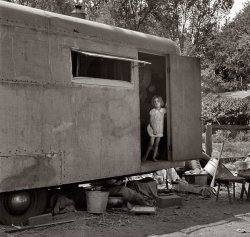
- When I Was a Kid: 1936
- ... family. Five children aged two to seventeen." Photo by Dorothea Lange for the Resettlement Administration. View full size.
Five ... Posted by Dave - 05/29/2013 - 9:16am -
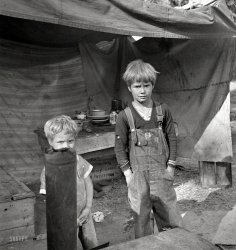
- Hovel-Ready: 1937
- ... project, Arizona." Medium format acetate negative by Dorothea Lange for the Farm Security Administration. View full size.
It's ... Posted by Dave - 02/17/2020 - 9:07pm -
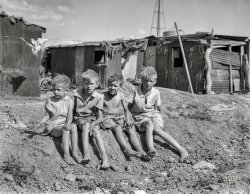
- Play Street: 1936
- ... for raising garden vegetables." Medium format negative by Dorothea Lange for the Resettlement Administration. View full size.
Housekeeping ... Posted by Dave - 02/07/2013 - 10:01am -
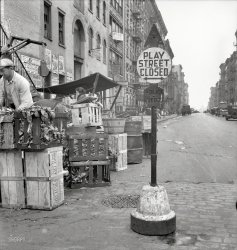
- Baby Carrot: 1937
- ... Imperial Valley, California." Medium format negative by Dorothea Lange. View full size.
This is a case for you know who Calling Joe ... Posted by Dave - 08/04/2017 - 3:18pm -
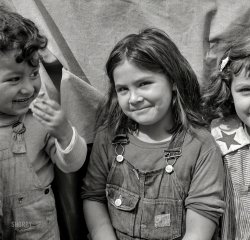
- Happiness Is: 1936
- ... camp. Kern County, California." Acetate negative by Dorothea Lange for the Farm Security Administration. View full size.
The ... Posted by Dave - 04/25/2020 - 8:36pm -
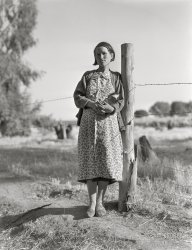
- Citrus Seedling: 1936
- ... picking season at Porterville, California." Photo by Dorothea Lange for the Resettlement Administration. View full size.
Maintaining ... Posted by Dave - 04/17/2013 - 10:20pm -
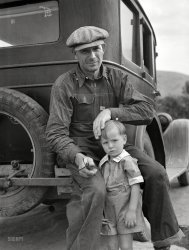
- Vegetable Kingdom: 1939
- ... approaching a thousand dollars." Medium format negative by Dorothea Lange for the Farm Security Administration. View full size.
The value ... Posted by Dave - 06/15/2018 - 10:55pm -
![Vegetable Kingdom: 1939 September 1939. "Ernest W. Kirk Jr. with his two sons on their farm near Ordway, Colorado. They hold fruits of their farm, coming from their labor, which has placed them in a few months from almost hopeless condition to a family with net worth approaching a thousand dollars." Medium format negative by Dorothea Lange for the Farm Security Administration. View full size.
The value of working hard$1,000 in 1939 works out to a tad over $18,000 according to the BLM inflation calculator.
Really oddMultiple pictures show he has a wife and a young daughter in addition to his two sons. And I believe I found an obit from his oldest son but they are nowhere to be found in the 1940 Census.
PerspectiveMy parents bought their first house for $500 during the 1930s. Dad made the huge sum of $40 a month. $1000 may not be a lot of money today, but it was a sizable sum back then.
High cost of goodiesBack in those days candy bars were a nickel, as was a bottle of pop, six pack was a quarter. When I was sent to the store I sometimes got a penny or two for candy, if I was lucky. We had quite a choice, from licorice cigarettes, licorice chewing tobacco, white candy cigarettes -- lotsa goodies, all for a penny.
The importance of beingIn the 1940 Census our man is listed as Earnest W. Kirk Jr., born in Oklahoma in 1900. In 1925 he married to Ester Adams, born in Oklahoma in 1905. The two boys are Earnest (b. 1928) and Carl D. (1932); they had a sister, Delorise, born in 1937.
["Delorise" -- really? - Dave]
(The Gallery, Agriculture, Dorothea Lange, Kids)](https://www.shorpy.com/files/images/SHORPY-8b22782a1.thumbnail.jpg)
- Mrs. Wardlaw: 1939
- ... Malheur County, Oregon. View full size. Photograph by Dorothea Lange.
This is my Great Grandmother This is a picture of my ... Posted by Dave - 09/08/2011 - 5:16pm -
![Mrs. Wardlaw: 1939 October 1939. Mrs. Wardlow [Wardlaw] at the Society of Friends church. Dead Ox Flat, Malheur County, Oregon. View full size. Photograph by Dorothea Lange.
This is my Great GrandmotherThis is a picture of my great-grandmother Eva Wardlaw. They misspelled are name as Wardlow. She was born in August 1891 and died in 1963. She had four children. To date she has over 100 descendants.
Agnes Lorraine (Ruda) BorbaHi,
I was doing family research when I saw a Agnes Lorraine (Ruda) Borba with connection to a Scott Wardlow genealogy.
If you are the right person please email me. I have alot concerning Agnes.
She is on my Borba line.
Email me at marcioborba_genea@yahoo.com
Happy Holidays
(The Gallery, Dorothea Lange, Rural America)](https://www.shorpy.com/files/images/8b35187u.thumbnail.jpg)
- Bean Pickers: 1939
- ... to North Dakota. View full size. Photograph by Dorothea Lange.
(The Gallery, Dorothea Lange, Great Depression, Kids) ... Posted by Dave - 09/07/2011 - 9:55pm -
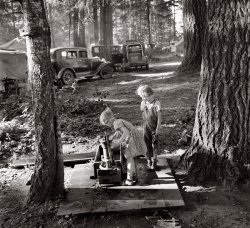
- Farm Dad: 1939
- ... and do not go to school. Malheur County, Oregon." Photo by Dorothea Lange for the Farm Security Administration. View full size.
With 7 you ... Posted by Dave - 06/21/2020 - 12:18pm -
![Farm Dad: 1939 October 1939. "George Cleaver, new farmer on 177 acres, has five boys. The three older boys, ages 12, 16 and 18, are needed at home to develop the farm and do not go to school. Malheur County, Oregon." Photo by Dorothea Lange for the Farm Security Administration. View full size.
With 7 you get eggrollPer the 1940 Census, the family was a bit larger. There was also a first born daughter, Georgia Ruth Cleaver Elliot (born 1917), who evidently didn't move west with the family, remaining in Missouri.
Large families were popular with the Cleavers. The eldest son, Lester (1918-1998), also farmed. As of 2016 when his widow Virginia died, there was a family left behind of 10 children, 38 grandchildren, 100 great grandchildren and 18 great great grandchildren.
School DaysI never forget back when I was in grammer school back in the 50s students who lived on a farm were excused from school during the fall to help with the crops which were an all hand evolution before all the big mechanical harvesters. Don't try that now.
["Grammer" school! - Dave]
Body language doesn't lieAnd theirs, along with their relaxed and happy facial expressions, bespeaks a close relationship. Maybe money was tight, but they were successful in ways that we could use more of today.
(The Gallery, Agriculture, Dorothea Lange, Kids)](https://www.shorpy.com/files/images/SHORPY-8b38823a_0.thumbnail.jpg)
- Wright Whirlwind: 1942
- ... instant out of time, altering life by holding it still.” Dorothea Lange
"65 years ago" Makes you want to go find a DeLorean and ... Posted by Dave - 08/09/2012 - 12:34pm -
![Wright Whirlwind: 1942 August 1942. Mechanic Mary Josephine Farley works on a Wright Whirlwind motor in the Corpus Christi, Texas, Naval Air Base assembly and repairs shop. View full size. 4x5 Kodachrome transparency by Howard R. Hollem.
My God.I'm sitting here looking at this beautiful woman, and then I realise ... 65 years ago.
Older than my motherYeah I'm 51 and whenever I look at these beautiful women I have to keep reminding myself that they were all born before my 79-year-old mother.
There's something about them though that makes them seem more in synch with our times than the women of say a decade later. Don't know what it is.
Mary JosephineThis is Joe Manning, of the Lewis Hine Project. I found this in the Archival Collection at Texas Woman’s University.
“Mary Josephine Farley Tilton, Letters, 1943-1944, 5 folders. Native of Aransas Pass, Texas. Worked as an engine mechanic and Link trainer instructor during World War II, then joined the Women Air Force Service Pilots (WASP), class 43-W-4. Later was commissioned in the Air Force. Served in Germany during the Korean War. Graduated in 1965 from Midwestern University with a B.S. Degree in Elementary Education and became a teacher. Letters (all photocopies), written to her family, document Tilton's experiences as a WASP trainee at Avenger Field Sweetwater, Texas, and a ferry pilot based at Love Field, Dallas, Texas. Also includes news articles and a copy of "The Flying V," newsletter of Love Field's ferrying group and a color copy of photograph [1943 or 1944]. Gift of Mary Josephine Tilton, 1995.
Mary JosephineThis touching photograph is quite similar to a painting by Norman Rockwell.
“Photography takes an instant out of time, altering life by holding it still.” Dorothea Lange
"65 years ago"Makes you want to go find a DeLorean and a flux capacitor.
Mary Josephine FarleyI am uploading a photo of her in her WASP uniform taken in 1943.
[Thank you, whoever you are! - Dave]
ColourizationInteresting with all the comments on colourization, that here is another colourized shot.
My first job in a photo studio was making prints for the artist downstairs to colourize. We would make a black and white print, and then "sepia tone" it (boy, that smelled). The sepia would add the warm tones to areas not painted. On the back of the print we would write all the colours to be used -- "complexion," "hair colour," "eye colour," "misc." She would then use transparent dyes to add the colour and varnish over it (or "fixative" in the later years).
(The Gallery, Kodachromes, Aviation, Howard Hollem, WW2)](https://www.shorpy.com/files/images/1a34879u_0.thumbnail.jpg)
- Ten Families: 1938
- ... alfalfa and dairy products for cash crops." Photo by Dorothea Lange for the Farm Security Administration. View full size.
Dead Ringer ... Posted by Dave - 05/12/2014 - 10:22am -
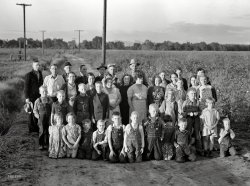
- Morning Mail: 1938
- ... to community farming." Medium format acetate negative by Dorothea Lange for the FSA. View full size.
Replaced by FSA housing It took a ... Posted by Dave - 08/13/2020 - 9:29am -
![Morning Mail: 1938 November 1938. "Morning mail at the Mineral King cooperative farm, Farm Security Administration, Tulare County, California. Old ranch house, California type, in the background. Buildings will be replaced by modern structures suitable to community farming." Medium format acetate negative by Dorothea Lange for the FSA. View full size.
Replaced by FSA housingIt took a bit of digging, but it turns out that Mineral King Ranch is a different place from the named place in Sequoia-Kings Canyon National Park.
But here's a view of the surviving homes that took the place of this old farmstead:
Should we hang around for another delivery?The caption implies that these boxes got more than one daily delivery, though the USPS website says that "as a rule, rural carriers have always delivered mail to their customers once a day, six days a week."
When free home delivery in cities began in 1863, the guideline was "as frequently as the public convenience shall require." Multiple daily deliveries were common, though cutbacks reduced these, particularly during the Depression and World War II. Finally, on April 17, 1950, the Postmaster General ordered once per day home delivery, "in the interest of economy."
[As the caption implies, the Farm Security Administration's cooperative farms got multiple daily deliveries. - Dave]
DetritusI’m wondering about all the organic matter in the dirt road in the foreground. The trees appear to me to be plane and maybe palm – is all that stuff from the trees? Or some kind of farm byproduct? I see quite a few pods or beans. Never having been to California, I’m unfamiliar with these things.
[One palm and multiple eucalypti. - Dave]
F.G. HendersonI believe the F.G. Henderson mailbox belongs to a Frank Glenn Henderson. He would have been 40 years old in 1938. Amongst other corroborating evidence (including 1938-40 California voting rolls), I find Frank in the 1940 Census, which describes him and family living in Union Township, San Joaquin County. The Census confirms Mr. Henderson resided in Visalia (Tulare County) in 1935. His profession is listed as dairyman, working on a FSA dairy farm.
Frank Glenn Henderson @ Find A Grave.
[NB: The Census shows *him* living there. Not "he." - Dave]
[I earlier edited from 'him' to 'he'. Pffft. I'm clearly overdue for a self-directed grammar refresher course. And yes, I appreciate correction(s) when committing an error. - d&v]
Modern structures suitableWhat I don’t understand is how those tiny new sad bungalows (thank you, ContextSans) – the “modern structures suitable to community farming” – were considered superior to the “old ranch house, California type” which they replaced. The old house was bigger and so could hold more people, and was probably breezier, and generally roomier. Plus those replacement houses look awfully postwar to me.
EucalyptusStill a very common sight in many parts of California. It was introduced from Australia in the late 19th century by the Southern Pacific Railroad, as a fast-growing source of cross ties. It proved too brittle for that purpose, but landowners continued to plant eucalyptus as windbreaks.
(The Gallery, Agriculture, Dorothea Lange, Kids)](https://www.shorpy.com/files/images/SHORPY-8b32497a.thumbnail.jpg)
- Mommy's Little Soldier: 1939
- ... from Broken Bow, Oklahoma." Medium format negative by Dorothea Lange for the Farm Security Administration. View full size.
What a ... Posted by Dave - 04/25/2018 - 8:16pm -
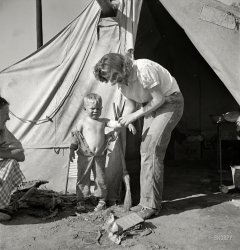
- Georgia Gothic: 1937
- ... house in Greene County, Georgia." 4x5 acetate negative by Dorothea Lange, Farm Security Administration. View full size.
Handyman's ... Posted by Dave - 11/19/2017 - 4:14pm -
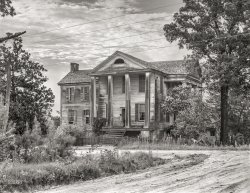
- A Billion Beets: 1939
- ... Nyssa, Malheur County, Oregon." Medium format negative by Dorothea Lange for the Farm Security Administration. View full size.
Beets, Me ... Posted by Dave - 01/31/2018 - 6:30pm -
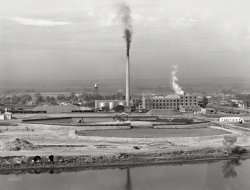
- GAS: 1939
- ... and Fresno on U.S. 99." Medium format acetate negative by Dorothea Lange for the Farm Security Administration. View full size.
Price of ... Posted by Dave - 01/19/2020 - 6:11pm -
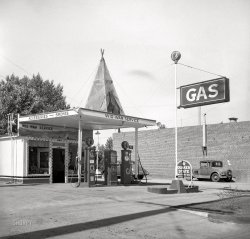
- Six Bits a Day: 1938
- ... make no hungry march." View full size. Photograph by Dorothea Lange.
Hard Life The years of pain are so evident on these faces it's ... Posted by Dave - 07/05/2009 - 2:36am -
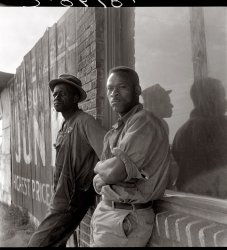
- The Gardeners: 1936
- ... seventy dollars a month." 4x5 inch nitrate negative by Dorothea Lange for the Resettlement Administration. View full size.
That's ... Posted by Dave - 11/27/2015 - 3:37pm -
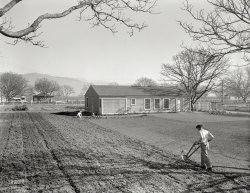
- On the Stump: 1939
- ... subsistence farm, whittled out of the stumps." Photo by Dorothea Lange for the Farm Security Administration. View full size.
Mixed ... Posted by Dave - 10/05/2017 - 4:03am -
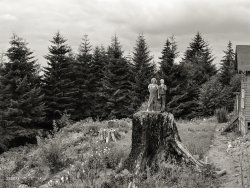
- Covert Auction: 1938
- ... crop at the tobacco auction." Medium format negative by Dorothea Lange. View full size.
I'll bet That she's not much over 40. ... Posted by Dave - 03/28/2017 - 3:33pm -
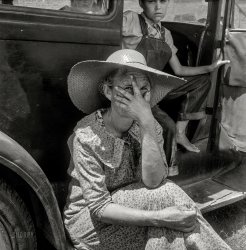
- Western Exposure: 1938
- ... The route many refugees cross." Medium format negative by Dorothea Lange for the Farm Security Administration. View full size.
Refugees? ... Posted by Dave - 02/18/2020 - 1:18pm -
![Western Exposure: 1938 June 1938. "New Mexico desert. Highway No. 70. The route many refugees cross." Medium format negative by Dorothea Lange for the Farm Security Administration. View full size.
Refugees?What do they mean by refugees? From where? Dust Bowl maybe?
[Drought refugees. - Dave]
What a StretchWould we have loved a stretch of road like this in the late '70s to run our very used and tired muscle cars bought during our high school years. Living in the Boston area even back then there wasn't much running room to open up on.
Stunningly beautifulI'm only sorry it was a trail of tears for drought refugees.
(The Gallery, Dorothea Lange, Landscapes, On the Road)](https://www.shorpy.com/files/images/SHORPY-8b32414a.thumbnail.jpg)
- Well Wisher: 1937
- ... "Sharecropper boy near Chesnee, South Carolina." Photo by Dorothea Lange for the Resettlement Administration. View full size.
Excerpt from ... Posted by Dave - 11/04/2015 - 1:40pm -
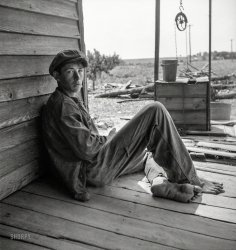
- Package Deal: 1937
- ... David, Cochise County, Arizona." Medium format negative by Dorothea Lange, Farm Security Administration. View full size.
Prosperous part of ... Posted by Dave - 12/21/2017 - 10:12am -
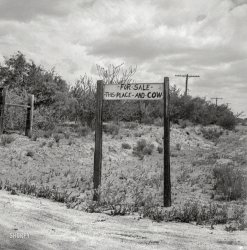
- In the Sticks: 1935
- ... This photo reminded me of the Migrant Mother 1936 by Dorothea Lange. The hard times had both women either suffering tooth aches or holding ... Posted by Dave - 07/28/2013 - 12:19am -
![In the Sticks: 1935 Sept. 1935. "Daughter of farmer who will be resettled. Wolf Creek Farms, Ga." Photo by Arthur Rothstein for the Resettlement Administration. View full size.
The SticksInstruments of attitude adjustment in those days I dare say.
[They're for the laundry. - Dave]
Sometimes.
Depression miseryThis photo reminded me of the Migrant Mother 1936 by Dorothea Lange. The hard times had both women either suffering tooth aches or holding their heads in despair. The Depression brought an equality of desolation for men, women and children.
Dreams and aspirationsA powerfully simple, evocative photo that makes one wonder what were her dreams and aspirations. Was she doomed to isolation and lifelong poverty? Did the resettlement give her a second chance at life?
What kind of shoes are those?They look like Chuck Taylors!
topkicksGotta love her well worn pair of hi-top sneakers,Converse maybe ?
ClassicIt looks like she's wearing a pair of well-used Chuck Taylor High Tops.
Chuck Taylor ConverseAccording to Wikipedia, at least, Chuck Taylor All-Stars have been around since 1917, so it's very possible that is exactly what she is wearing. Quite a long-lived style!
It could be my mother,she went through the depression on the prairies in Saskatchewan, and when I asked her what it was like she would never mention one event about those horrible times.
Amazing Photograph and subject.I'm mesmerized by this for some reason. There's big dreams in those eyes.
SneakersThe ribbed toe, stitching, and emblem on the sneakers indicate that they are they are more likely a style of Keds introduced in 1934 by the U.S. Rubber Company (later known as Uniroyal). If so, the farmer's daughter's shoes were less than two years old at best.
U.S. Rubber's Keds claimed to have launched the original sneaker brand - Champion - in 1916, a year before the Converse Rubber Shoe Company introduced their All Star version. Keds even claimed to have popularized the very word sneaker - despite the fact that the word had been synonymous with canvas and rubber tennis shoes for years.
In 1934 Keds with the the Scientific Last and Shockproof Insole were available in all-black or black and white, which was reminiscent of the style they replaced.
PF Flyers (by BF Goodrich) wouldn't make the scene until 1937.
(The Gallery, Arthur Rothstein, Rural America)](https://www.shorpy.com/files/images/SHORPY_8b26703u.thumbnail.jpg)
- No Future Here: 1939
- ... too old, If I could get the chance to farm. " Photo by Dorothea Lange for the Farm Security Administration. View full size.
Home ... Posted by Dave - 05/23/2018 - 7:16pm -
